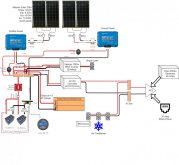Al Slitter
Trying to learn something new every day!
I am trying to wrap my mind around this topic and hope by sharing my thoughts it will confirm or provide for something I have missed.
Using a cheap BMS versus an expensive one has obviously quality differences but in addition the cheaper BMS have preset upper and lower
voltage cut offs and the cannot be changed.
However with my solar controller (Tracer 4215bn ) I intend on using it to control the battery pack. The thoughts that I have about this is that the BMS works at the cell level while the solar controller works at the battery level, I hope that I have explained this well enough!
If I use conservative values for both disconnects at the controller level it will negate the preset values of the cheaper BMS?
My thoughts are setting the cut offs at 13.35Volts (3.375 Volts at the cell Level) on the high end and 12.8 Volts (3.2 volts at the cell level) on the low voltage disconnect based om a 12 Volt system.
Thoughts please.
Using a cheap BMS versus an expensive one has obviously quality differences but in addition the cheaper BMS have preset upper and lower
voltage cut offs and the cannot be changed.
However with my solar controller (Tracer 4215bn ) I intend on using it to control the battery pack. The thoughts that I have about this is that the BMS works at the cell level while the solar controller works at the battery level, I hope that I have explained this well enough!
If I use conservative values for both disconnects at the controller level it will negate the preset values of the cheaper BMS?
My thoughts are setting the cut offs at 13.35Volts (3.375 Volts at the cell Level) on the high end and 12.8 Volts (3.2 volts at the cell level) on the low voltage disconnect based om a 12 Volt system.
Thoughts please.
Last edited:





